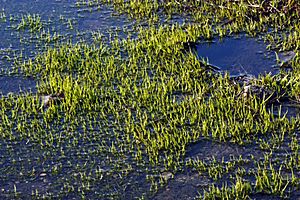Black-spored quillwort facts for kids
Quick facts for kids Black-spored quillwort |
|
|---|---|
 |
|
| Conservation status | |
| Scientific classification | |
| Genus: |
Isoetes
|
| Species: |
melanospora
|
| Synonyms | |
|
|
The black-spored quillwort (Isoetes melanospora) is a very rare and special water plant. It is also known as black-spored Merlin's grass. This plant is a type of lycophyte, which are ancient plants related to ferns. It is found only in the U.S. states of Georgia and South Carolina. This makes it an endemic species, meaning it lives in a specific place and nowhere else.
Where It Lives
The black-spored quillwort grows in shallow, temporary pools. These pools are often found on large granite rocks called granite outcrops. The plant can grow even with only about 2 centimeters (less than an inch) of soil.
Most of these plants live in Georgia. There are 11 known groups of them there. Only one group has ever been found in South Carolina. Sadly, scientists believe this group in South Carolina no longer exists.
Why It's Endangered
The number of places where this plant grows has dropped a lot. It used to be found in 18 different spots. Now, there are fewer because of habitat destruction. This means the places where the plants live are being harmed or destroyed.
Some reasons for this destruction include:
- Quarrying: This is when rocks are dug up from the ground, which destroys the pools.
- Trash dumping: People sometimes throw trash in these areas, making them unhealthy for plants.
- Trampling: People walking or stepping on the plants can hurt them.
What It Looks Like
The black-spored quillwort is a small plant. It usually grows in mud or shallow water. When the ground dries out, it can live on land too.
Here are some features of the plant:
- Rootstock: The base of the plant, where the roots grow, is almost round.
- Leaves: Its leaves can be up to 7 centimeters (about 2.8 inches) long. They grow in a spiral shape and get narrower towards the tip.
- Megaspores: These are like large seeds. They are gray or black and are about 350 to 480 micrometers wide. A micrometer is a tiny unit of measurement.
- Microspores: These are smaller spores, like tiny seeds. They look brown and are about 26 to 31 micrometers across.
During the fall and winter, new leaves quickly grow after it rains. But in the dry summer months, the leaves usually shrivel up.
Protection Status
The black-spored quillwort is a federally listed endangered species. This means the government has decided it needs special protection to keep it from disappearing forever.
Sometimes, this plant grows near another rare plant called the pool sprite (Amphianthus pusillus). Both of these special plants are protected at Stone Mountain in Georgia.



